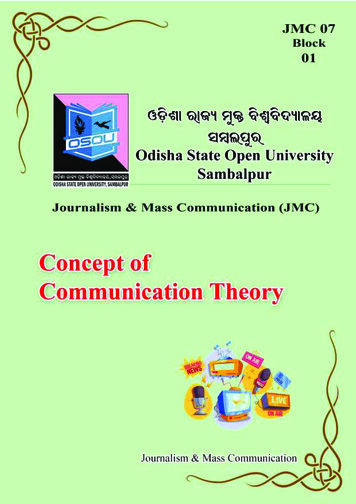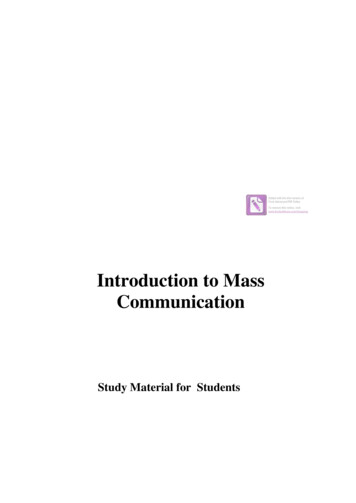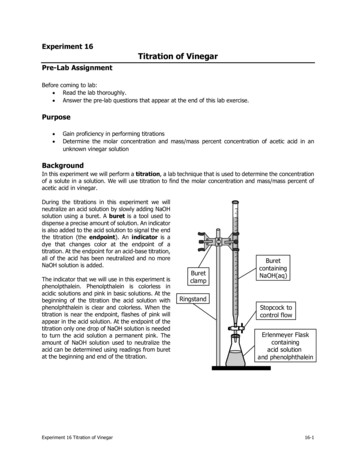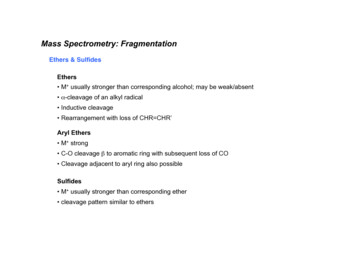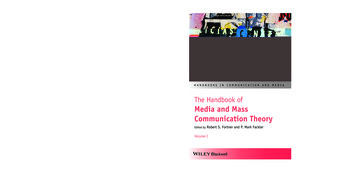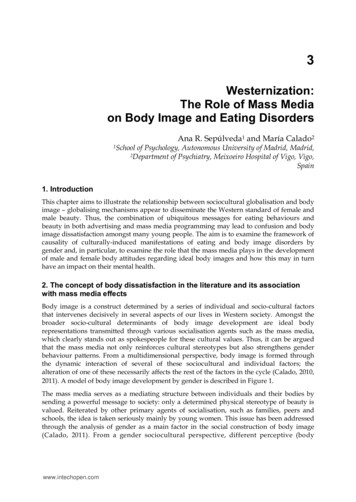
Transcription
3Westernization:The Role of Mass Mediaon Body Image and Eating DisordersAna R. Sepúlveda1 and María Calado21Schoolof Psychology, Autonomous University of Madrid, Madrid,2Department of Psychiatry, Meixoeiro Hospital of Vigo, Vigo,Spain1. IntroductionThis chapter aims to illustrate the relationship between sociocultural globalisation and bodyimage – globalising mechanisms appear to disseminate the Western standard of female andmale beauty. Thus, the combination of ubiquitous messages for eating behaviours andbeauty in both advertising and mass media programming may lead to confusion and bodyimage dissatisfaction amongst many young people. The aim is to examine the framework ofcausality of culturally-induced manifestations of eating and body image disorders bygender and, in particular, to examine the role that the mass media plays in the developmentof male and female body attitudes regarding ideal body images and how this may in turnhave an impact on their mental health.2. The concept of body dissatisfaction in the literature and its associationwith mass media effectsBody image is a construct determined by a series of individual and socio-cultural factorsthat intervenes decisively in several aspects of our lives in Western society. Amongst thebroader socio-cultural determinants of body image development are ideal bodyrepresentations transmitted through various socialisation agents such as the mass media,which clearly stands out as spokespeople for these cultural values. Thus, it can be arguedthat the mass media not only reinforces cultural stereotypes but also strengthens genderbehaviour patterns. From a multidimensional perspective, body image is formed throughthe dynamic interaction of several of these sociocultural and individual factors; thealteration of one of these necessarily affects the rest of the factors in the cycle (Calado, 2010,2011). A model of body image development by gender is described in Figure 1.The mass media serves as a mediating structure between individuals and their bodies bysending a powerful message to society: only a determined physical stereotype of beauty isvalued. Reiterated by other primary agents of socialisation, such as families, peers andschools, the idea is taken seriously mainly by young women. This issue has been addressedthrough the analysis of gender as a main factor in the social construction of body image(Calado, 2011). From a gender sociocultural perspective, different perceptive (bodywww.intechopen.com
48Relevant Topics in Eating DisordersFig. 1. Model of factors contributing to the development of body image amongst youngpeople by gender (Adapted from Calado, 2011)functioning), cognitive (thoughts about the body, nutrition or situations that interfere inlife), affective and behavioural (affective-sexual relations and behaviours) processes insociety are generated, which will affect the formation of a positive or negative body image.The differences regarding the gender body standard go beyond physical appearance as bothbody representations lead to two very different ways of appreciating the body.Socialisation agents such as television, internet, cinema and printed media project the ideathat ideal body images can be reached through body control and change and that it is solelyup to a person’s resolve to realise these ideals. This implies moving from the representationof ideal bodies to providing information on how to achieve them. However, in many casesthe images presented as ideal prove to be unachievable (unless through aggressive methodssuch as cosmetic surgery) as they have probably, prior to their publication, been airbrushedand retouched, and thus become unreal.The variable that continues to be unalterable in content analysis of body control in women isweight. Obesity stereotypes tend to include the belief that weight is controllable (Blaine &McElroy, 2002; Crandall & Martínez, 1996) and overweight people tend to be portrayed asgreedy, weak and lazy, whilst miracle weight-loss results are normalised by experts (Blaine& McElroy, 2002). Recent criticism in this direction led to weight loss advice stressing morethe importance of health, which was thus associated with thinness (Calado, 2010). Wisemanet al. (1992) found that since 1981 joint weight loss and exercise magazine articles hadincreased indicating a possible cultural redefinition of methods for weight loss. Previousstudies had reported articles based solely on dieting as a weight loss mechanism (Garner etal., 1980; Toro et al., 1989).Finally, the association between an ideal body and social values must be pointed out. Idealbody shapes are associated with personality traits and positive values, enhancing even moretheir desirability. The beauty ideal becomes a value in itself and trends that move indifferent directions are frowned upon. Thin women are therefore associated with wealth,www.intechopen.com
Westernization: The Role of Mass Media on Body Image and Eating Disorders49health, control and beauty, whilst being fat is associated negatively with weakness, laziness,lack of control and unhealthy lifestyles. These dynamics lead to the attribution of positivevalues, including being more intelligent, friendlier and more determined, to thinner peopleon television (Fouts & Burggraf, 1999).Several studies have discussed the relationship between mass media and the developmentof body dissatisfaction from the assumption that the ideal of beauty can deeply impact aperson’s body attitudes and behaviours (Grabe et al., 2008; Groesz et al., 2002). Thus,aesthetic standards based on the ideal stereotype of thin women and muscular men, maylead to conform idealised cultural values and are considered possible determinants of bodyimage dissatisfaction. These cultural values are unique in that persons are apparentlysubject to powerful and continuous reinforcing mechanisms through exposure to consistent,reiterative and persuasive thin-ideal images (Blaine & McElroy, 2002; Cusumano &Thompson, 1997; Hogan & Strasburger, 2008; Wiseman et al., 1992).Existing research reflects a complex reality in which the debate continues as to whetherthese forms of mass media imply a cause and effect relation or if they are a correlationrelationship. The majority of findings are provided by correlational research on therelationship between exposure frequency to the thin ideal and body dissatisfaction(Cusumano & Thompson, 1997; Grabe et al., 2008). These studies showed that reading fashionand fitness magazines, exposure to television music videos and access to specific contentthrough internet or social network websites, such as Facebook or Twitter (Cusumano &Thompson, 1997; Hatoum & Belle, 2004; Hogan & Strasburger, 2008), were associated withbody dissatisfaction amongst adolescents due to reiterative exposure to idealised beautyimages and, in turn, triggered the desire to lose weight because of this influence. Furthermore,several experimental investigations have suggested that exposure to thin media images led toan increase in body dissatisfaction (Grabe et al., 2008; Groesz et al., 2002). The meta-analysis of25 experimental studies by Groesz et al. (2002) showed that participants were significantlymore dissatisfied with their bodies after viewing thin-idealised models than after viewingaverage-sized models, plus-sized models, or inanimate objectsHowever, the majority of society is exposed to reinforcing messages by the mass media thatmay cause body image dissatisfaction and does not develop unhealthy attitudes and/orbehaviours. The question, therefore, would be to ask what individual factors may beworking as translators of these social messages that function as risk factors for disorderedeating behaviours. In other words, what psychological processes are triggered in a personby which he or she becomes more vulnerable to the group of beliefs, values and attitudesreceived by socialising agents.Longitudinal studies are crucial for distinguishing causal risk factors in order todemonstrate whether the exposure to mass media precedes and predicts the development ofdisturbed body image and disordered eating. There are less published studies that suggestthat early exposure to the thin-ideal can predict an increase in body image dissatisfaction.Dohnt and Tiggemann (2006) interviewed a sample of 97 girls aged 5 to 8 years to studyhow they incorporated the desire for thinness and satisfaction with appearance, and therelationship of this association with their self-esteem. A year later, the variable watchingappearance-focused television programmes predicted an increase of appearancedissatisfaction and, subsequently, the girls' desire for thinness was found to precedetemporarily low self-esteem. Thus, it appears that a greater exposure to music television showswww.intechopen.com
50Relevant Topics in Eating Disordersand appearance-focused magazines leads to a stronger level of dieting awareness. This isconsistent with another study by Harrison and Hefner (2006), in which greater overalltelevision exposure predicted both a thinner ideal adult body shape and a higher level ofdisordered eating in a sample of girls aged 7 to 12 years. In an older sample of college-agedwomen, Aubrey (2006) studied the total exposure to sexually objectifying television andmagazines and found that the exposure to the media predicted levels of self-objectification(defined as the attributes applied to one s physical self-concept) a year later, especially inwomen with low self-esteem. According to Aubrey, the exposure to mass media could beassociated with an increase in viewers’ definitions of their physical selves in terms ofexternally perceivable traits (i.e. body appearance) rather than internal traits (i.e. body control).One explanation for this process is that exposure to televised objectification cultivates aparticular view of the self, a view that emphasises the importance of physical appearance.3. The association of the effects of the mass media with the Westernisationof the body image according to genderIt appears that sociocultural factors may affect female and male adolescents differently;whilst exposure to the muscular ideal has been associated with greater body dissatisfactionin male adolescents, females have reported the desire to be thinner (Farquhar & Wasylkiw,2007; Hatoum & Belle, 2004).Research has frequently assessed weight as a body dissatisfaction indicator for women, suchas studies on Miss America pageants and Playboy centrefolds. In most cases researchersagree that the ideal body weight for women has decreased progressively over the last 30years (Garner et al., 1980; Silverstein et al., 1986; Spitzer et al., 1999). This trend is alsoapparent in television and cinema, which represent women as thinner than the social norm(Fouts & Burggraf, 2000; Fouts & Vaughan, 2002).Less attention is paid to male body representations, although this has been graduallychanging in recent years. Historically, male ideal body images have been associated withmuscle bulk, such as the lead actor of the iconic film Rambo. There is less of a consensus inpublished studies on this topic, but there appears to have been an increase in the desireamongst men for muscularity as reported by Leit et al., (2001) in their review of Playgirlmodels and by Spitzer and colleagues (1999) in male models.Images that are represented by the media tend to transmit and reinforce dominant culturalideologies as well as reject representations that question these stereotypes. Calado (2011)shows that these stereotyped body messages generate discrimination dynamics regardinggender roles and the ideal body image (Figure 2), and convey false ideas of reaching thisideal through processes of body transformation and of social success associated with specificbody images, as well as possibly trigger unhealthy behaviours.The objectification of women is based on an ideal of youth and thinness, and the objectificationof men is based on thinness as well, but also muscularity and fitness. The reemphasising ofthese ideals creates the false idea that ideal body images are atemporal, static andimmutable, resulting in an unbalance and selection of certain body shapes and exclusionand invisibility of others. This leads, as mentioned previously, to a homogenisation of theideal body by gender.www.intechopen.com
Westernization: The Role of Mass Media on Body Image and Eating Disorders51Amongst the sociocultural factors that most influence negatively female and, progressivelymore, male body image perceptions are stereotypical ideal body representations transmittedthrough different socialisation agents and most notably the mass media. The mass mediaappears to exercise powerful social learning processes by means of negative and positivereinforcement of mechanisms of beliefs and behaviours. However, these mechanisms tendtowards homogenisation through stereotyped and single-viewed notions regarding beautyand the rejection of reality, that is to say, heterogeneous and made up ethnicities, ages andshapes.Fig. 2. Sociocultural messages influential in shaping body image (Adapted from Calado, 2011)The spread of these rigid, stereotyped and dichotomic messages conveys an oversimplified,homogeneous and incomplete picture of reality, allowing for further associations betweenlow self-esteem and body dissatisfaction. An example of this can be found in the televisionprogramme Extreme Makeover where participants and viewers are led to believe that theirself-esteem can only improve if they have previously undergone a radical transformation oftheir body image (Cocimano, 2004). The association between a certain type of body,personality traits and success is also reinforced by the mass media through the portrayaland glorification of celebrities. The constant emphasis on the association between celebritiesand their body image (by the mass media) reaffirms the belief that success can only beobtained if accompanied by an ideal body. These associations have been studied by Plaza(2005), who examined 519 celebrities in women’s magazines and found that they wereusually attributed with positive values such as professionalism and the ability to work hard.Life experience, however, was relegated to a lesser issue as most celebrities were under 30years of age. Once again, the youth versus maturity dichotomy can be observed.On the other hand, sociocultural beauty standards do not flow in parallel for both genders.This asymmetry has been reported in studies that have assessed the parts of the body whichwww.intechopen.com
52Relevant Topics in Eating Disordersare of most concern to men and women. In this respect, gender differences regardingcontent and structure of the dimensions associated with the body are relevant. Men tendedto be more concerned about their bodily strength (chest, arms or muscles), whilst womenwere more concerned about their weight (body shape satisfaction or size of breasts)(Blowers et al., 2003). The impossibility of attaining either of these body ideals triggeredemotions such as fear, depression or anxiety.Another differentiating gender element linked to body image is the aging experience, orrather, the double standard for aging. Halliwell and Dittmar (2003) found attitudes towardsaging in women to be centred mainly on the physical aspect of their bodies and thus, agingwas considered negative as physical attraction decreased and became disassociated with thesocial value of youth. On the other hand, for men, aging had a negative impact on theirphysical ability, whilst changes in their appearance were seen as more neutral or even aspositive. Social beliefs of masculinity underline traits such as ability, autonomy, energy andself-control, all of which supposedly increase through aging. Therefore, men may viewaging as a process that enhances their appeal and, although they also expressed negativeattitudes towards body aging, these were not as marked as in the female sample.Women tend to interiorise their role as body-objects and value themselves regarding theirphysical appearance; in comparison, men appear to focus more on the aspects of their bodyassociated with function and thus may present higher self-esteem. The prevailing socialconditions appear to lead women towards associating their self-worth with their bodysatisfaction, whilst this synergy does not appear to apply to men. Furthermore, the linkbetween body and self-esteem may influence women to consider as secondary otherpersonal aspects, such as intellectual, artistic or social skills, generating a global singlefactored self-esteem associated with their self-perceived physical appearance (Calado, 2011).Martínez-Benlloch (2001) has argued that gender content (masculinity/femininity) isexpressed in the manner that they are assumed at adolescence. Boys are inclined to focustheir self-worth on variables such as self-control, personal power, competitiveness andphysical functioning (a dynamic picture of the body), and girls tend to associate their selfworth with weight concerns, sexual attraction and body objectification.These sociocultural influences appear to have functioned as a protective factor for bodyimage disorders in men. However, there appears to be recent trend suggesting a progressiveinversion. Halliwell and Dittmar (2003) in their study of a male sample reported significantdifferences regarding ages. Younger males, who were more effected by sociocultural bodyimage pressures, exhibited behaviours aimed at changing parts of their bodies they weredissatisfied with, whereas differences by age were not found in the female sample. This factsuggests that levels of concern amongst men may increase in the future. Overall, it seemsthat the body can be shaped to fit particular ideals and beliefs as a personal project.An up-to-date review by López-Guimera et al. (2010) has accumulated evidence that the massmedia are an extremely important source of information and reinforcement in relation to thenature of the thin beauty ideal and how to attain it. However, less evidence was found for theprocesses implicated in this relationship, though these are deserving of further research. Theseauthors have postulated that there are at least three processes that convey the relationshipbetween the media, body dissatisfaction and disordered eating: internalisation of the thinbeauty ideal, social comparison and activation of the thinness schema. Moreover, social andfamily support play a crucial role in the awareness and reinforcement of the thin beauty idealwww.intechopen.com
Westernization: The Role of Mass Media on Body Image and Eating Disorders53and disordered eating behaviours, which could work as a protective factor for low awarenessand internalisation of the thin-schema (López-Guimera et al., 2010).4. Homogenisation processes of the body ideal regarding physical beauty indifferent culturesBody image research has argued that body gender stereotypes change from one culture toanother and over time. Thus, ideal beauty would be different for every culture as everyculture establishes standards that are adopted by varying expressions according to thehistoric period of the society (Frith et al., 2006). These beauty standards generate anomalousconcerns and behaviours linked to body image and directed at obtaining these ideals.There are diverse practices of beauty across cultures. For example, in China, until fairlyrecently, an attribute of female beauty was having small feet, leading to the bandaging ofyoung girls’ feet in order to stunt growth. This practice was initiated when the girl wasbetween the ages of four and seven, and was widespread for over a thousand years. InMyanmar, a long neck is associated with beauty. Paduang women wear coiled brass neckrings to the point of not being able to remove them because of bone and tissue deformation.In Sumatra, teeth filing was a common practice. Across Africa, skin scarification – wheredecorative designs are cut into the skin to emphasise beauty as well as ethnic origins – hasbeen practised for centuries. Moreover, some African cultures have seen the deliberatefattening of women as a sign of beauty, fertility, health and prosperity. Amputation andmutilation have been practiced amongst the Mongoni tribe in Malawi. In Arabic culture,henna has been used for centuries on special occasions to decorate the body with boldgeometric designs. There are many more examples, perhaps as many as cultures with theirown beauty ideals. Traditional African, Asian and Arabic cultures have been cited asexamples where, at the very least, thinness was not emphasised as a requirement forfeminine beauty (Calado 2011; Soh et al. 2006). However, even across cultures, to attainthese ideals of beauty at times implied subjecting oneself to risk behaviours or practices,mainly as regards the female gender.However, because of globalising dynamics and global access to Western socialising agents’messages, there appears to be an increasing trend in ideal body image homogenisationregarding gender. That is, there appears to be an increasing belief that the beauty ideal hasbecome stable.These social agents have exported a Eurocentric concept of beauty to the rest of the world.Historically, even the Eurocentric beauty standard regarding ideal body shape has changedin the last 50 years, moving from more voluptuous female shapes to extremely stick-thinbody shapes, such the British model Twiggy in the 1960s, and this has never really yieldedto a more normal average-sized female body (Frith et al., 2006). Indeed, the stereotypes of athin body ideal for women and a muscular body ideal for men may also facilitate a fullrange of unhealthy weight loss practices to control the body image (Gandarillas et al., 2003;Grogan, 2006; Perez-Gaspar et al., 2000), which may lead to idealised cultural values. Bodyimage dissatisfaction and disordered eating have apparently influenced more severelywomen and this has been associated with the etiology of several psychological andpsychiatric disorders. Body dissatisfaction increases the drive for thinness and dieting; anddieting is the greatest risk factor for the development of an eating disorder. Adolescentwww.intechopen.com
54Relevant Topics in Eating Disordersfemales, who diet only moderately, are five times more likely to develop an eatingdisorder than those who do not diet, and those who diet severely are 18 times more likelyto develop an eating disorder (Patton et al., 1999). In terms of psychiatric cases, a numberof epidemiological studies have presented similar eating disorders prevalence rates,around 4.5% in Western countries (Favaro et al., 2003; Gandarillas et al., 2003; PerezGaspar et al., 2000), although this rate may be higher if subclinical cases are included(approximately 8%).Across cultures, Asian and black women are increasingly considered beautiful when theymeet Eurocentric ideals in terms of body shape, skin color and hair texture and,unsurprisingly, cosmetic surgery and health care products have become a ready solution.China, Japan and South Korea are amongst the top seven countries where cosmetic surgeryis performed, along with the United States, India, Brazil and Mexico (Haas et al., 2008).According to the American Society of Plastic Surgery, approximately 11.7 million cosmeticsurgical and nonsurgical procedures were performed in 2007. This is a 457% increase since1997. Globally, almost 13.2 billion was spent on cosmetic surgical procedures in 2007 (Haaset al. 2008). Many Asian women opt for surgery in order to copy the chins, big eyes or highbridged noses of popular Western actresses. Evidence suggests that this leaning towards aWesternised appearance starts at an early age; dark haired Asian women now play withblonde-haired Barbie dolls when children. Ultimately, older Caucasian females also undergoone form or another of cosmetic surgery to address aging in their quest for youth. Otherforms of body intervention are performed by all ages, mainly lipoplasty and breastaugmentation (Haas et al. 2008). Men have also become targets of these beauty messages,although the intensity and number of advertisements seem to pale into insignificance whencompared to women. Nevertheless, this homogenisation of beauty across gender, cultureand ethnicity is a trend that allows for mechanisms of social control by cosmetic industries,which also accumulate high profits from the transmission of these messages (Hesse-Biber etal. 2006). Moreover, Haas et al. (2008) reviewed the reasons for undergoing cosmetic surgeryand found that these were mainly motivated by psychological and psychosocial factors and,in some cases, psychiatric disorders. Recently, increasing eating disorders rates have alsobeen reported in non-Western societies, such as the Middle East (Nobakht & Dezhkam,2000), China (Huon et al. 2002) and Japan (Chisuwa & O’Dea, 2010), although the prevalencerates are still far below those in Western countries.The case of Fiji is an outstanding example of global-marketing of beauty standards and howthese have affected traditional culture norms previously immune to body disturbance anddisordered eating. Fijian culture traditionally holds a robust and rounded body image as thenorm for females and males. In contrast, a slim body was considered unhealthy. Only threeyears after the arrival of television in 1995, dominated by Western broadcast programmesand films, Fijian society noted a drastic increase in eating disorders and generaldissatisfaction with physical appearance. In other words, these disorders had not beenrecorded (or did not exist) until the advent of televised media on the islands (Becker, 2004).Other examples could be considered illustrative cases, although the methodology is morelimited and the results debatable. In the case of Iran, the country banned Western mediaafter the fall of the Sha and, therefore, Iranians were not exposed to the thin body beauty. Ina particular study, female and male Iranian college students were compared with theirAmerican counterparts. As expected, the Iranian female students scored considerably higherwww.intechopen.com
Westernization: The Role of Mass Media on Body Image and Eating Disorders55than the U.S. participants when asked to assess their body-esteem, while men, from bothcountries, scored higher than the women (Akiba, 1998). These results suggest that thecurrent access to Western mass media has had a more significant impact amongst the femalepopulation. Another study carried out by Nasser (1994) confirmed that unhealthy eatingbehaviours and the desire to be thinner were emerging in Egyptian culture amongstsecondary school students in opposition to values traditionally placed on rounded femalebodies. Lastly, Caradas et al. (2001) conducted research in South Africa in order to comparebody image issues amongst white and black girls. Their findings indicated that theprevalence of abnormal eating attitudes was equally common in schoolgirls from differentethnic backgrounds.Certainly, Westernisation and globalising values have permeated the majority of nonWestern cultures and established body image ideals and eating behaviours. As regards themedia, it is fairly easy to see that a significant number of Western television programmeshave been adapted to different countries (Asian, Latin American, etc) and dubbed in variouslanguages. Publicity tends to be more local for cooperate reasons, but these advertisementsare also, in many cases, generic commercials believed to appeal to a variety of countries andare, consequently, aired and dubbed all over Western Europe. The same can be said forprinted media that either offer different versions of globalised magazines (Hello, Cosmopolitan,etc) or publish magazines that imitate in form and content Western publications.In this context, it is also important to assess the degree of acculturation regarding overexposure to idealised images within the African-American, Asian-American and LatinAmerican communities. There has been less research assessing body dissatisfaction or eatingdisorders in minority groups. Clinical criteria developed for Caucasian populations do noteffectively map illnesses for non-Western samples, thus, information is still uncertain andscarce. Several studies, however, confirmed as a result of ethnicity and cultural conflict wassignificantly related to body dissatisfaction and maladaptive eating attitudes (Alegria et al.,2007; Cummins & Lehman, 2007; Hesse-Biber et al., 2004). The study by Akan and Grilo(1995) reported that Caucasians had greater levels of disordered eating and dietingbehaviours and attitudes and greater body dissatisfaction than Asian-Americans andAfrican-Americans who differed little on these measures. Likewise, a history of being teasedabout weight and size was associated with unhealthy eating behaviours and bodydissatisfaction in Caucasians but not in Asian-Americans. A further study that compared aCaucasian and an African-American female sample suggested the latter group hadappearance concerns over the issues of hair and skin, specifically to straighten their hair andtry to achieve lighter skin tones, in an attempt to integrate aspects of both cultures into theirlives (Hesse-Biber et al., 2004). In contradiction of these findings, however, another studyfound that African-American and Latin-American women differed little from Caucasianwomen in terms of body dissatisfaction and eating-disordered features (Hrabosky &Grilo, 2007). Recently, a rigorous eating disorder study carried out by Alegria et al. (2007)of Latin Americans in the United States found elevated rates for binge eating but lowprevalence of anorexia nervosa. Specifically, foreign birth was associated with a decreasedrisk of binge eating and those who spent more than 70% of their lifetime in the U.S.reported the highest rate for an eating disorder. In short, findings suggest that there existssome support for the risk effect of acculturation and racial differences regarding eat
Body image is a construct determined by a series of individual and socio-cultural factors that intervenes decisively in several aspects of our lives in Western society. Amongst the broader socio-cultural determinants of body image development are ideal body representations transmitted thr



